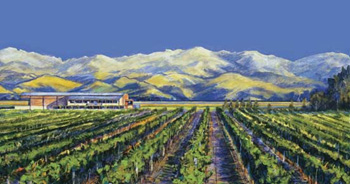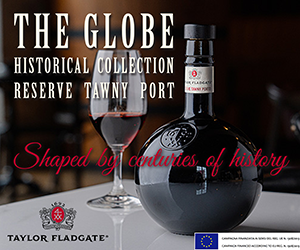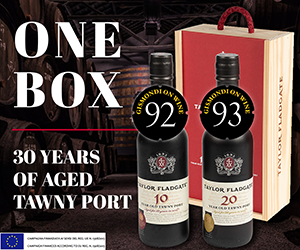For Montana the 2004 harvest delivered not only the expected record quantities, but brought some real surprises with the outstanding quality of fruit from new vineyards.
The size of the harvest in Marlborough exceeded the record 2002 intake by a massive 50%, while both Gisborne and Hawke's Bay produced slightly more than in 2002. Fruit across the board was of good quality - clean and well-balanced, with strong flavours.
The quantity of Sauvignon Blanc, mainstay of New Zealand's wine exports, is such that Montana can go onto the front foot again with its export programme, further developing the market for New Zealand wine in key markets such as the UK, US and Australia. Montana's new Conder's Forest vineyard in Marlborough yielded its first full vintage from 2001 Sauvignon Blanc plantings and the fruit is superb, auguring well for wines from the 2004 vintage.
Pinot Noir, which is set to become New Zealand's next international wine success story, also delivered significantly more volume as new vineyards come on stream. The Pinot Noir from top Marlborough vineyards has winemakers very excited by its quality and flavour profile.
Tony Hoksbergen, Montana's national vineyard manager, described the vintage as a delightful balance between yield and quality. He said it is particularly gratifying to see company owned and grower vineyards that were decimated by frost last year return to full production.
"After many years of planning and vineyard development, we have finally delivered a vintage that will allow Montana to take a significant step towards meeting the seemingly insatiable demand for our wines internationally," says Hoksbergen.
"We are also excited by our new vineyard areas, such as Waipara, which have delivered flavour profiles that are markedly different from that produced in our more established grape-growing regions."
Montana's chief winemaker, Jeff Clarke, says the 2004 vintage would have to rate alongside the classic 1998 vintage in terms of quality.
HAWKE'S BAY
The fruit harvested in Hawke's Bay has been "absolutely superb", according to winemaker Tony Prichard. Quantities have also returned to normal levels, slightly exceeding the record intake of 2002.
Unsettled weather over spring and summer raised fears of a troubled harvest, when wet weather led to excessive canopy growth which had to be trimmed. The weather settled down from mid-February and the fruit responded beautifully, developing to become well-balanced with good sugar levels and strong fruit flavours.
"The Chardonnays are fresh and vibrant and the reds show no herbaceousness," says Prichard. The quality of the fruit is such that Montana's pinnacle Bordeaux-style red wine, Tom, will definitely be made this year.
Fellow winemaker Jeff Clarke says at this early stage the reds can be compared to that from the legendary 1998 vintage. "While 1998 was warmer overall, viticultural and winemaking techniques have advanced so much since then that our wines from this year should be very desirable."
Other highlights include the first main crop of Sauvignon Blanc from Montana's Ngatarawa vineyard.
GISBORNE
In Gisborne the intake was slightly above that of the big 2002 vintage, while the quality, too, was generally even higher.
"I would rate this vintage better than 2002 on the basis that we've had some naturally low-yielding vineyards, delivering grapes with stronger flavours and an even better balance between sugar and acid than in 2002," says winemaker Steve Voysey.
A relatively wet spring and growing season did not bring the anticipated disease pressure in the vineyards, as rain tended to come in bursts, followed by drying winds. Cool weather towards harvest allowed the grapes to ripen at a steady pace and they were harvested at optimum ripeness and in good condition.
"It was the biggest Lindauer vintage we've ever done and the best quality fruit too," says Voysey.
The prospects for all the white wines from Gisborne look good and both the flagship wines - Ormond Estate Chardonnay, which was not made last year, and the Patutahi Estate Gewürztraminer - will have 2004 vintages. Some of the Merlot harvested was also exceptional.
MARLBOROUGH
In Marlborough Montana harvested 50% more than the previous record, set in 2002. This is due to a combination of new vineyards coming on stream and good growing conditions which led to heavier cropping Sauvignon Blanc in particular.
The weather for flowering and fruit set was so good that crop thinning was required to ensure that we attain the desired quality levels. After a hot period in December and January, the wet February was welcomed. Cooler weather slowed up fruit development and the berries increased in size, yielding heavy bunch weights for especially Sauvignon Blanc, with larger berries than normal.
While small berries (and thus a greater ratio of skin to pulp) are generally desirable for red varieties, it did not have a detrimental effect on this year's Sauvignon Blanc, as the wine is made with minimal skin contact and the physiologically well-developed fruit delivered the distinctive Sauvignon Blanc flavours. The fact that the growing season was longer than normal allowed intense fruit flavours to develop over time. Winemakers expect more aromatic wines with greater fruit lift than the norm.
A highlight in the region has been the first year's plantings at Conder's Forest that have now come into full production. "This vineyard delivered marvellous Sauvignon Blanc," says viticulturist Mike Insley. "With another 150ha in this vineyard coming on stream next year, the prospects are very exciting."
Winemakers are especially optimistic about the outstanding quality of the Sauvignon Blanc from the Rapaura side of the Wairau valley, where frosts limited their options last year. Much of this fruit goes into the Stoneleigh range.
Insley says Montana's belief in the potential of the Terraces vineyard to produce exceptional Pinot Noir has been fully vindicated by the quality of the fruit harvested on this sloping vineyard this year.
Winemaker Patrick Materman says the Pinot Noir throughout the region stands out this year, with soft tannins and full fruit aromas.
WAIPARA
Conditions in Waipara were in many ways similar to that in Marlborough. This year Montana took the first sizeable Pinot Noir harvest from the Omihi vineyard, as well as a very small crop of Riesling and Pinot Noir from the Camshorn vineyard. These quantities will continue to increase strongly over the next three vintages.
"The Pinot Noir from Waipara is stunning," says winemaker Patrick Materman. "It is notably different from Marlborough fruit and we expect bigger, denser wines with a darker fruit spectrum, more earthy and complex compared the bright red fruit aromas in Marlborough."

 quicksearch
quicksearch






